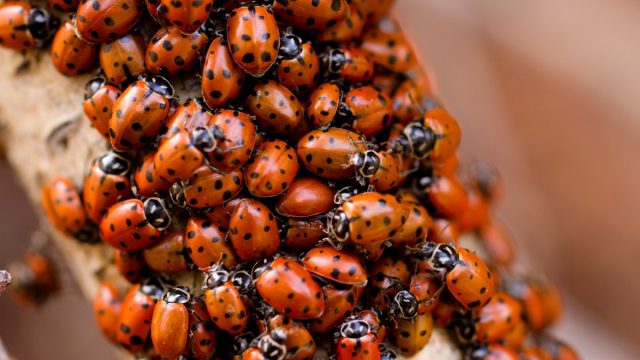Invasive Ladybugs Are Spreading and Excreting “Foul-Smelling” Blood—How to Keep Them Out

Unlike a spider, cockroach, or other seemingly sinister creatures, spotting a ladybug in your home isn’t likely to make you squirm or scream. In fact, ladybugs are commonly thought to be a good omen, bringing luck when they land on you or cross your path. At the same time, certain kinds of invasive ladybugs can present big problems if they make their way inside of your home—including unpleasant smells.
RELATED: “Very Large” New Spider Species Discovered—Here’s Where There May Be Hiding.
The problematic variety are Asian lady beetles (Harmonia axyridis), as Emma Grace Crumbley, entomologist at Mosquito Squad, tells Best Life.
“They get their name from their origin in Asia and were introduced to the U.S. in the late 1980s,” she says. “Their appearance is nearly identical to that of native ladybugs with the exception of two key characteristics: their lighter, more orange coloration, and the presence of an ‘M’ shape on their pronotum (the shield-like part of the body that covers the head).”
According to Crumbley, unlike ladybugs that are native to the U.S., the invasive variety also like to make their way into homes.
“While an occasional ladybug or two may stumble into a home or hitchhike on a person’s clothes as they’re coming through the door, Asian lady beetles will enter homes in larger groups and all at once,” she shares. “Though they don’t pose any structural damage or human health concerns, their large invasions can be a nuisance for homeowners seeking peace of mind in fall and winter.”
On top of being a nuisance, when they feel threatened, these ladybugs produce “a foul-smelling fluid from their leg joints, which can leave stain marks on walls and fabrics,” Crumbley says.
According to Charles van Rees, PhD, conservation scientist, naturalist, and founder of the Gulo in Nature blog, this fluid is a defense mechanism that ladybugs often use against “large threats like people.”
“This is intended to offend would-be predators so that they can escape. Reflex bleeding is the entomological term for the mechanism by which ladybugs do this,” he explains. “Rather than secrete these chemicals through specialized glands or other tissues ‘meant’ to release these chemicals, they simply squeeze out some of their own haemolymph (the equivalent of blood), mixed with these offensive chemicals, through the gaps in their exoskeletal ‘armor.'”
Thankfully, ladybugs aren’t poisonous to humans (although they can bite if they’re feeling sufficiently threatened). But if a pet ingests multiple ladybugs, it could end up getting sick, Megan Wede, marketing manager and co-owner of Done Right Pest Solutions, tells Best Life. She also points out that ladybugs can stir up allergens when they make their way into wall voids and vents.
With all that in mind, you should work to keep ladybugs out of your house if possible. Now is the time for action as well, as these beetles are cold-blooded and more likely to break in when temperatures drop, Crumbley says.
“Like other overwintering insects, ladybugs will take advantage of any entry points they can find,” van Rees cautions. “Gaps in siding, around windows or doors, and doors or windows left ajar during the fall will create an opportunity for them. Ladybugs will typically not start looking to get into your home until winter is on its way, so that is the time to be most cautious.”
Read on to find out how experts recommend keeping ladybugs out of your house—and what to do if it’s already too late.
RELATED: 6 Things Attracting Mice Into Your Basement.
1
Block any holes or entry points.

Wede notes that ladybugs can get in through cracks as small as one-eighth to one-quarter inch in diameter. (For comparison, mice need the full quarter-inch.)
So, while winter has already arrived, it’s still worth it to take a look around your house and check for any potential entry points, especially around siding, windows, and doors, according to van Rees.
“Use a steel wool, copper mesh, or other type of metal mesh to close the gaps, or try a foam like Great Stuff,” Wede advises. “If there are any larger openings, you may need caulk, cement, or other adhesive. It’s possible you may run into a deficiency that may need a handyman services provider’s or licensed contractor’s help.”
RELATED: Top 10 Things Attracting Snakes to Your Home.
2
Use a mixture of dish soap and water.

Wede also recommends using a mixture of water and dish soap, specifically the Dawn brand, to keep ladybugs from invading.
“This is something I recommend if you have edible food plants around the exterior of your home and you don’t want to use chemicals,” she says. “This also works on the interior of the home to kill off ladybugs.”
She continues with a word of caution: “This method is very tedious because you’ll need to re-apply it every couple of days, whether on the inside of the home (if they are already inside your home) or on the outside of your home in the fall (weather wears off the soap and water mixture). If you have the time to spend applying this method, it is a good option.”
According to HowStuffWorks, you should spray the mixture in areas where ladybugs are likely to congregate, or on the bug directly if you spot one.
3
Check “undisturbed” areas of your home.

Crumbley notes that you can find ladybugs throughout your home, but large infestations are more likely in areas “that go undisturbed for long periods of time,” so staying on top of those can save you some time and a potential bill from a professional service.
“The attic, or uppermost part of the home (eaves, high shelves, even light fixtures) tends to have the most ladybeetles hiding out,” she reveals. “Heat rises, and especially in cooler months, insects want to hang out where the heat is.”
RELATED: The No. 1 Thing Attracting Mosquitoes to Your Yard.
There are options if you’re dealing with an ongoing infestation.

As January has arrived, you might have missed the boat on preventive measures. However, experts say that there are a few ways to clear ladybugs out.
After you’ve sealed all potential entry points to ensure new ladybugs can’t make their way in, experts recommend non-chemical approaches like glue strips or vacuums to do away with ladybugs.
“If you’re not worried about harming them, they can be removed using a vacuum cleaner, especially if they’re in a tight or hard-to-reach place,” van Rees says. “Otherwise, I typically just scoop them up in my hand or use a brush and dustpan or jar and piece of paper. Handling ladybugs is generally safe, although you may get a bit of their stinky ‘frightened juices’ on you.”
When you “escort” ladybugs outside, van Rees suggests finding them an alternative home for the winter, like in a leaf litter or the hollow of a tree.
One thing you shouldn’t do when dealing with a ladybug infestation on your own, however, is use store-bought chemicals, Crumbley warns.
“While there are a number of over-the-counter products you can buy that claim to work on every pest, these products are not meant to fortify and protect your home year-round,” she says. “Additionally, dead lady beetles may attract other nearby pests and lead to further issues.”
If all else fails, it may be time to call in professional pest control services to treat baseboards and entry points with a chemical that is safe for you, but will kill the ladybugs, Wede notes. This is particularly important if you suffer from allergies, she says.
For more pest advice delivered straight to your inbox, sign up for our daily newsletter.